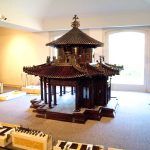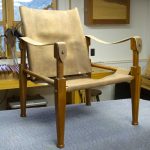We may receive a commission when you use our affiliate links. However, this does not impact our recommendations.
As a child, I disliked assembling puzzles. What’s the fun in piecing together hundreds of pieces of cardboard into a flat image of a happy whale family?
But Lincoln Logs, on the other hand, had my full attention. Yes, I know I was not a consistent child.
This week I drove to the Headley-Whitney Museum in Lexington, Ky., to watch a team of eight men disassemble an 800-piece puzzle made of red sandalwood in the shape of the Ten Thousand Springs Pavilion. The original pavilion, known as Wan Chun Ting, sits on a man-made hill in the Forbidden City (check out the awesome photos here). The pavilion was built about 1420 (rebuilt in 1533) and offers beautiful views of the Forbidden City.
This sandalwood replica was built about 10 years ago and was donated to the Smithsonian by the China Red Sandalwood Museum in Beijing, according to Don Williams of the Smithsonian, who leads a team of volunteers that move the 1:5 replica to museums around the country.
This week, the team of volunteers had to take apart the pavilion, pack each part into specially designed crates and prepare them for their journey to the International Museum of Art & Science in McAllen, Texas, where it will be installed there the last week of January and will tentatively be on exhibit for six months.
From a woodworker’s perspective, the pavilion is a fantastic study in carving and joinery (not to mention form). The entire replica pavilion is assembled without nails. Lincoln Logs? Ha. Wait until you see Ming Logs. As the volunteers removed the carvings and the roof structure, I got to examine the support structure below, which was a maze of interlocking bridle joints. Many of these bridle joints have circular shoulders so they could mate with round columns.
And they all had to fit together loosely enough to go together with hand pressure, yet tighten up enough that the entire structure was as rigid as a real house when complete (and weighing one ton).
The detail – inside and out – was astounding. The doors to the pavilion were built using through-mortise-and-tenon joints. And the pierced latticework was all carved from solid panels of sandalwood. And the raised panels (shown in the video) were also carved from solid.
If you have an opportunity to see this pavilion in Texas, don’t miss it.
— Christopher Schwarz
Here are some supplies and tools we find essential in our everyday work around the shop. We may receive a commission from sales referred by our links; however, we have carefully selected these products for their usefulness and quality.















If you want to see a fascinating, full scale example of a somewhat similar building, check out the Olbrich Botanical Gardens Thai Pavilion in Madison, WI. They built it piece by piece in Thailand, then flew it over here and assembled it in Madison. An awesome building, I was just there a couple of weeks ago. http://www.olbrich.org/events/thaianniversary.cfm
NOWWW ya tell us this is going on. I live about 35 miles away… and would have been happy to bring some ‘refreshements’ along for the two of you PopWood folk – plus some for the rest if they would allow me to “help”.
Looks interesting… Now I’d have to drive to the bottom of the nation to see something similar!!
TWH
Winchester, KY
I noticed in the list that #10 was Ling-Kung. Perhaps you could call these “Ling-Kung logs”? Sorry, I couldn’t resist…
HI: I love your blog, your writing and your presentations. You are a major contributer to woodworking. However, attached to an email about registering for your blog, is a long and for me very objectional video about saving money on power bills. It is very political and misleading in many ways. You may not know that your name is being used in an unfortunate way. Please check this out. Many thanks. Dick
I’m familiar with the three Greek orders, but I didn’t know that the same concept existed in Chinese architecture. I wonder if there are orders other than the one shown in the drawing. I did a Google search and ended up at a bunch or take-out sites. There was a Buddha Jumped Over The Wall chef’s special that looked mighty tempting.
Awesome find! At last, a reason to make the 6-hour drive to McAllen (I live in Austin). I doubt we’d get the same chance to examine the joinery as closely as Schwarz & Co., but it’d still be most groovy to see.
I can’t stand puzzles of any kind (jigsaw, crosswords, sudoku). I think it is because there is only one answer. I prefer subjective issues (drawing, furniture, web design, etc.)
Wow! This looks like the Shakespeare of woodworking. Are the plans available to buy anywhere? I don’t have the time left to duplicate this, but it would be fun to follow the joinery, and maybe use some in simpler pieces.